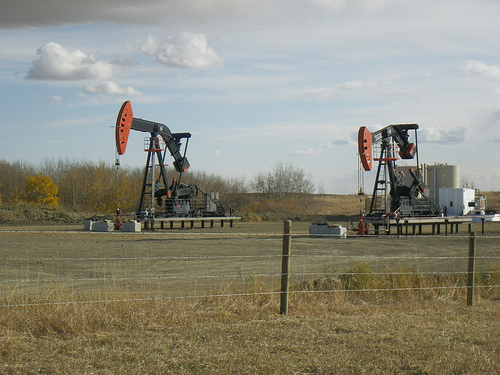Want to know why Canada’s currency is sky-high despite our sluggish recovery, our large and persistent current account deficit, and our lousy export performance?
Check out this fascinating story in Friday’s National Post, by Yadullah Hussain, on why Canada’s oil reserves are such a uniquely hot commodity in the eyes of global oil corporations.
The story explains how private petroleum giants (like Exxon-Mobil) are having a hard time replacing the reserves they produce. Over 80 percent of known oil reserves in the world are controlled by state-owned companies. Most major oil producing countries (sensibly, in my view) have decided that management and ownership of this strategic, non-renewable resource should be conducted through government enterprise, presumably in the interests of the citizens who — after all — own the stuff in the first place. (Of course, democracy is a prerequisite for ensuring that public ownership translates into public benefit.)
That means less than 20 per cent of known oil reserves are available for exploitation by private companies. Incredibly, well over half of those privately exploitable reserves are in Canada. Without Canada, private firms like Exxon can tap into only 7 per cent of known world reserves.
There is a striking chart that accompanied the print version of the story (but which I can’t find in the online version) that listed the countries with the 10 largest oil reserves. Canada was the only one of those 10 where the oil industry is not dominated by state-owned firms. (Canada doesn’t even have a state-owned oil company.)
The article cited Reynold Tetzlaff, energy expert with Price Waterhouse Coopers, as follows: “If you look at the top … countries … for oil reserves, Canada is the only one that does not have a national oil company. We are the only one open for business.”
Given sky-high oil prices and oil profits, and the relentless decline of their existing reserves, the global petroleum industry has their sights set firmly on Canada as a key solution to their long-run reserves replacement problem. Indeed, even foreign state-owned companies (from Norway’s Statoil to China’s CNPC) are getting in on Alberta’s bitumen action in a big way. It seems especially ironic that foreign public corporations see value in investing in Canadian oil, yet Canadians presently have no public capacity to do the same thing.
“These large companies need to continue to look for replacement reserves,” Mr. Tetzlaff added. In other words, Canada will be the hottest target for private oil investment for decades to come.
All that drooling on the part of global petroleum companies over Canada’s oil (which is uniquely accessible to private capital) is the key structural reason why our currency has so closely tracked the price of oil over the past decade. Our petroleum exports are important, but still constitute just 18 per cent of total exports (including natural gas). It is not that the world wants more of what Canada produces: if that was true, Canada would not have the enormous trade and current account deficits that we now experience (despite the unsustainable windfall of petroleum exports). Rather, it’s that global companies hunger for the right to own what’s buried under our feet. This is reflected in high valuations for Canadian assets (especially anything related to petroleum), and (to a lesser extent) in strong inflows of real foreign investment as our oil resources are steadily sold off to the highest bidder. This asset market effect, driving our currency far above its fair or sustainable value, is undermining our national capacity to produce and sell real stuff to the rest of the world.
As I have argued before, a good way to break this damaging link between oil prices and our currency (the 25 per cent overvaluation of which continues to devastate all non-resource export industries, including manufacturing, tourism, and tradable services) is to take down the “For Sale” sign currently hanging on our oil reserves.
Following the lead of the vast majority of other global oil exporters, control over the pace and nature of development should be taken back into the hands of Canadians. The non-renewable wealth embodied in those reserves should be owned and controlled by Canadians, developed in a manner consistent with the public interest — taking into account factors (like environmental sustainability, and spillover Dutch-disease effects on the rest of the national economy) that do not enter the cost-benefit calculations of the private giants hungering for Canadian oil.
Jim Stanford is an economist with the CAW. This article was first posted on The Progressive Economics Forum.



